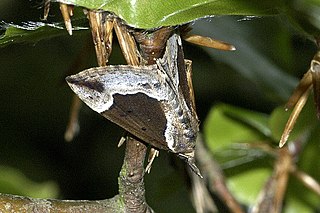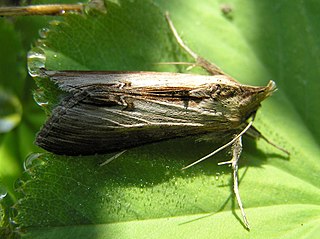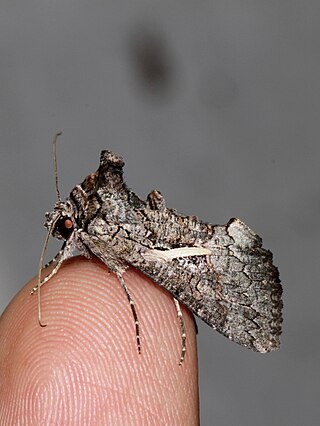
The mullein moth is a noctuid moth with a Palearctic distribution. The species was first described by Carl Linnaeus in his landmark 1758 10th edition of Systema Naturae.

Mythimna l-album, the L-album wainscot, is a moth of the family Noctuidae. The species was first described by Carl Linnaeus in his 1767 12th edition of Systema Naturae. It is distributed throughout Europe, but is also found in North Africa from Morocco to Tunisia and in the Levant, then east across the Palearctic to Central Asia. It is not found in the far north of the Arabian Peninsula. The limit in the north varies. It occurs on the northern edge of the range as a migrant. From southern England, then Denmark and southern Scandinavia, the north limit cuts across the Baltic Sea across the Baltic states then south of Moscow to the Urals.

The Sprawler(Asteroscopus sphinx) is a moth of the family Noctuoidea. It is found throughout western Europe, but is mainly a Northern species occurring South to Northern Spain the southern edge of the Alps, Central Italy and Northern Greece. North to southern Sweden. East to Kaliningrad and Moscow. Also in Central Europe, Turkey, the Caucasus and Asia Minor.

Hypena crassalis, the beautiful snout, is a moth of the family Erebidae. The species was first described by Johan Christian Fabricius in 1787. It is found in Europe.

Cucullia asteris, or star-wort, is a moth of the family Noctuidae. The species was first described by Michael Denis and Ignaz Schiffermüller in 1775. It is found through the Palearctic including Japan.

Callopistria juventina, the Latin, is a moth of the family Noctuidae. The species is found across the Palearctic realm.

Lithophane semibrunnea, the tawny pinion, is a moth of the Noctuoidea family. It is found in scattered populations in North Africa, central and southern Europe and Asia Minor.

Synthymia is a genus of moths of the family Noctuidae. It contains only one species, Synthymia fixa, The Goldwing, which is found in southern Europe and North Africa.

Shargacucullia scrophulariae, the water betony, is a moth of the family Noctuidae. It is found throughout Europe, east to Turkey.

Catocala nymphagoga, the oak yellow underwing, is a moth of the family Erebidae. It is found in Southern Europe, from Bulgaria up to the Iberian Peninsula and sometimes further north as a migrant. It is also found in North Africa and Asia Minor.

Mesapamea secalis, the common rustic, is a moth of the family Noctuidae. The species was first described by Carl Linnaeus in his 1758 10th edition of Systema Naturae. It is found in Europe, north-west Africa, Turkey and northern Iran.

Ctenoplusia accentifera is a moth of the family Noctuidae. It is found in South-Western Europe, Greece, Africa, the Near East and Asia Minor.

The green-brindled dot is a species of moth of the family Noctuidae. It is found in southern Europe and the Middle East, then east to Iran and Ukraine. In Germany it is found up to the Eifel and Ahr.

Dichagyris musiva is a moth of the family Noctuidae. It is found in some mountainous areas of Europe, Turkey, Armenia, the Caucasus, Anatolia, southern Siberia, Mongolia, Tibet and western China.

Grammodes stolida, the geometrician, is a moth of the family Erebidae. The species was first described by Johan Christian Fabricius in 1775. It is found in Africa, southern Europe, most of Asia and Australia. It migrates to central and northern Europe as far north as England, Denmark and Finland.

The lesser-spotted pinion is a moth of the family Noctuidae. It is found in central and southern Europe, north to Great Britain, Denmark, southern Sweden up to Saint Petersburg. East, its range extends through northern and Central Asia up to Japan. It is also found in north-western Africa.

Cosmia pyralina, the lunar-spotted pinion, is a moth of the family Noctuidae.

The silky wainscot is a moth of the family Noctuidae. It is found in most of Europe including Russia.

Elaphria venustula is a moth of the family Noctuidae. It is found in most of Europe, except the north. In the east, the range extends through the Palearctic to the Pacific Ocean.

Mniotype adusta, the dark brocade, is a moth of the family Noctuidae. It was described by Eugenius Johann Christoph Esper in 1790. It is found throughout much of the Palearctic from Europe to Japan, China and Mongolia. It is also found in North America. The habitat consists of heathland, chalky downland, fenland, moorland and upland areas.




















